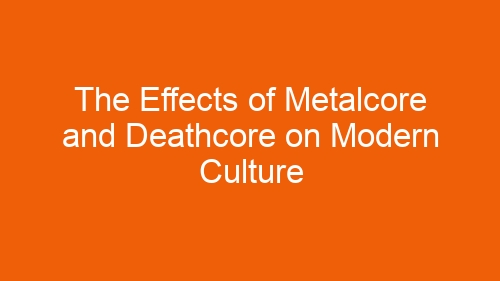-
Table of Contents
Influence of Metalcore and Deathcore on Fashion Trends
Metalcore and deathcore are two subgenres of heavy metal music that have had a significant impact on modern culture. While these genres are known for their aggressive sound and intense lyrics, they have also influenced fashion trends in a variety of ways.
One of the most noticeable ways that metalcore and deathcore have influenced fashion is through the clothing worn by fans of these genres. Both metalcore and deathcore fans often wear band merchandise, such as t-shirts, hoodies, and hats, featuring their favorite bands’ logos and album artwork. These items are not only a way for fans to show their support for the bands they love, but they also serve as a form of self-expression and a way to connect with others who share their musical tastes.
In addition to band merchandise, metalcore and deathcore fashion often includes elements of punk and gothic styles. Fans of these genres may wear black clothing, leather jackets, studded belts, and combat boots, as well as accessories like spikes, chains, and patches. These fashion choices reflect the dark and rebellious themes present in metalcore and deathcore music, and help fans to express their individuality and nonconformity.
Metalcore and deathcore fashion has also had an impact on mainstream fashion trends. Many elements of metalcore and deathcore style, such as black clothing, leather jackets, and combat boots, have been adopted by designers and incorporated into high fashion collections. This has helped to bring the edgy and rebellious aesthetic of metalcore and deathcore to a wider audience, and has made these styles more accessible to those who may not be familiar with the music.
Metalcore and deathcore fashion has also influenced streetwear and urban fashion trends. Many streetwear brands have incorporated elements of metalcore and deathcore style into their collections, such as graphic t-shirts, distressed denim, and oversized hoodies. These items have become popular among young people who are looking to make a bold fashion statement and stand out from the crowd.
Overall, the influence of metalcore and deathcore on fashion trends is undeniable. From band merchandise to high fashion collections to streetwear brands, the edgy and rebellious aesthetic of these genres has made a lasting impact on modern culture. Whether you’re a die-hard fan of metalcore and deathcore or simply appreciate their unique style, there’s no denying that these genres have left their mark on the world of fashion.
Impact of Metalcore and Deathcore on Youth Subcultures
Metalcore and deathcore are two subgenres of heavy metal music that have had a significant impact on modern culture, particularly on youth subcultures. These genres have gained popularity over the past few decades, attracting a dedicated fan base and influencing various aspects of society. From fashion and art to attitudes and beliefs, metalcore and deathcore have left their mark on the world in more ways than one.
One of the most noticeable effects of metalcore and deathcore on modern culture is the way they have shaped the fashion choices of many young people. Fans of these genres often adopt a distinctive style that includes black clothing, band merchandise, and accessories such as studded belts and leather jackets. This fashion sense has become synonymous with the metalcore and deathcore scenes, serving as a way for fans to express their allegiance to the music and the subculture it represents.
In addition to fashion, metalcore and deathcore have also influenced the art world, with many artists drawing inspiration from the themes and imagery found in the lyrics and album artwork of bands in these genres. Dark, macabre, and often violent imagery is common in metalcore and deathcore, and this has translated into the visual art created by fans and artists alike. From paintings and drawings to tattoos and graphic design, the influence of metalcore and deathcore can be seen in a wide range of artistic expressions.
Beyond fashion and art, metalcore and deathcore have also had a profound impact on the attitudes and beliefs of many young people. The aggressive and confrontational nature of the music often resonates with fans who feel alienated or marginalized by mainstream society. The themes of anger, rebellion, and defiance found in metalcore and deathcore lyrics can provide a sense of empowerment and solidarity for those who feel like outsiders. This sense of belonging to a community of like-minded individuals can be a powerful force in shaping the beliefs and values of young people.
Furthermore, metalcore and deathcore have played a role in shaping the way that young people interact with each other and with the world around them. The sense of camaraderie and shared identity that comes from being a fan of these genres can lead to the formation of tight-knit communities both online and in real life. These communities provide a support network for fans, offering a sense of belonging and acceptance that may be lacking in other areas of their lives. This sense of connection can be a source of strength and comfort for young people as they navigate the challenges of adolescence and young adulthood.
In conclusion, metalcore and deathcore have had a profound impact on modern culture, particularly on youth subcultures. From fashion and art to attitudes and beliefs, these genres have influenced a wide range of aspects of society. The sense of empowerment, solidarity, and community that comes from being a fan of metalcore and deathcore can be a powerful force in shaping the lives of young people. As these genres continue to evolve and grow in popularity, their influence on modern culture is likely to endure for years to come.
Evolution of Metalcore and Deathcore in Mainstream Music Industry
Metalcore and deathcore are two subgenres of heavy metal that have made a significant impact on modern culture, particularly in the music industry. Both genres have evolved over the years, gaining popularity and influencing a new generation of musicians and fans. In this article, we will explore the evolution of metalcore and deathcore in the mainstream music industry and the effects they have had on modern culture.
Metalcore emerged in the late 1990s as a fusion of hardcore punk and extreme metal, combining the aggression and intensity of both genres. Bands like Killswitch Engage, As I Lay Dying, and All That Remains helped popularize metalcore, bringing it to a wider audience. The genre’s blend of melodic hooks, breakdowns, and screamed vocals resonated with fans who were drawn to its raw energy and emotional intensity.
Deathcore, on the other hand, emerged in the mid-2000s as a fusion of death metal and metalcore, incorporating elements of both genres to create a more brutal and aggressive sound. Bands like Suicide Silence, Whitechapel, and Carnifex helped define the genre, with their guttural vocals, blast beats, and crushing breakdowns. Deathcore appealed to fans of extreme metal who were looking for something heavier and more intense than traditional metalcore.
Both metalcore and deathcore have had a significant impact on the mainstream music industry, influencing a new wave of bands and shaping the sound of modern metal. These genres have pushed the boundaries of heavy music, incorporating elements of other genres like electronic music, hip-hop, and pop to create a more diverse and dynamic sound.
Metalcore and deathcore have also had a profound effect on modern culture, influencing fashion, art, and even language. The aggressive and rebellious nature of these genres has inspired a new generation of fans to express themselves through music and art, creating a sense of community and belonging.
In terms of fashion, metalcore and deathcore have influenced a new wave of streetwear, with fans sporting band merch, tattoos, and piercings as a way to express their identity and connect with like-minded individuals. The dark and edgy aesthetic of these genres has also influenced the design of album covers, posters, and merchandise, creating a visual language that is instantly recognizable to fans.
In addition to fashion and art, metalcore and deathcore have also had an impact on language, with fans adopting slang and terminology from the genres to communicate with each other. Terms like “mosh pit,” “breakdown,” and “screamo” have become part of the lexicon of metalcore and deathcore fans, creating a sense of camaraderie and shared experience.
Overall, metalcore and deathcore have had a lasting impact on modern culture, shaping the sound of contemporary metal and influencing a new generation of fans and musicians. These genres have pushed the boundaries of heavy music, creating a space for self-expression and creativity that continues to resonate with fans around the world.




















